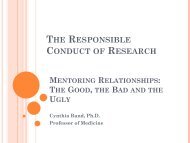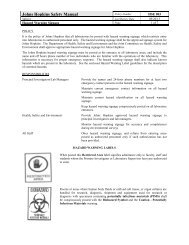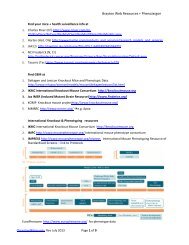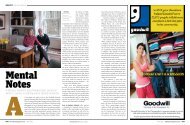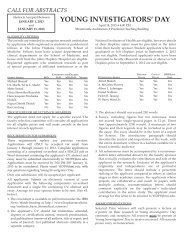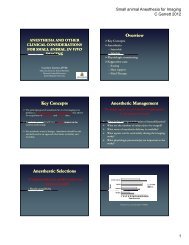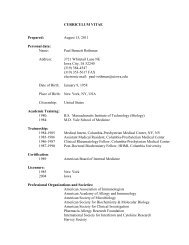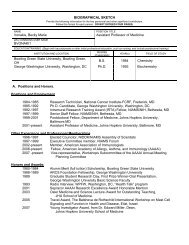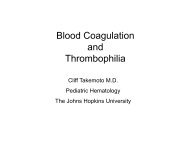Prevalence of Amblyopia and Strabismus in White and African ...
Prevalence of Amblyopia and Strabismus in White and African ...
Prevalence of Amblyopia and Strabismus in White and African ...
Create successful ePaper yourself
Turn your PDF publications into a flip-book with our unique Google optimized e-Paper software.
<strong>Prevalence</strong> <strong>of</strong> <strong>Amblyopia</strong> <strong>and</strong> <strong>Strabismus</strong> <strong>in</strong><br />
<strong>White</strong> <strong>and</strong> <strong>African</strong> American Children Aged<br />
6 through 71 Months<br />
The Baltimore Pediatric Eye Disease Study<br />
David S. Friedman, MD, MPH, PhD, 1,2 Michael X. Repka, MD, 3,4 Joanne Katz, ScD, 1,2 Lydia Giordano, OD, MPH, 1<br />
Joseph<strong>in</strong>e Ibironke, OD, 1,3 Patricia Hawse, MS, COMT, CRA, 1 James M. Tielsch, PhD 1,2<br />
Objective: To determ<strong>in</strong>e the age-specific prevalence <strong>of</strong> strabismus <strong>in</strong> white <strong>and</strong> <strong>African</strong> American children<br />
aged 6 through 71 months <strong>and</strong> <strong>of</strong> amblyopia <strong>in</strong> white <strong>and</strong> <strong>African</strong> American children aged 30 through 71 months.<br />
Design: Cross-sectional, population-based study.<br />
Participants: <strong>White</strong> <strong>and</strong> <strong>African</strong> American children aged 6 through 71 months <strong>in</strong> Baltimore, MD, United<br />
States. Among 4132 children identified, 3990 eligible children (97%) were enrolled <strong>and</strong> 2546 children (62%) were<br />
exam<strong>in</strong>ed.<br />
Methods: Parents or guardians <strong>of</strong> eligible participants underwent an <strong>in</strong>-home <strong>in</strong>terview <strong>and</strong> were scheduled<br />
for a detailed eye exam<strong>in</strong>ation, <strong>in</strong>clud<strong>in</strong>g optotype visual acuity <strong>and</strong> measurement <strong>of</strong> ocular deviations. <strong>Strabismus</strong><br />
was def<strong>in</strong>ed as a heterotropia at near or distance fixation. <strong>Amblyopia</strong> was assessed <strong>in</strong> those children aged<br />
30 through 71 months who were able to perform optotype test<strong>in</strong>g at 3 meters.<br />
Ma<strong>in</strong> Outcome Measures: The proportions <strong>of</strong> children aged 6 through 71 months with strabismus <strong>and</strong> <strong>of</strong><br />
children aged 30 through 71 months with amblyopia.<br />
Results: Manifest strabismus was found <strong>in</strong> 3.3% <strong>of</strong> white <strong>and</strong> 2.1% <strong>of</strong> <strong>African</strong> American children (relative<br />
prevalence [RP], 1.61; 95% confidence <strong>in</strong>terval [CI], 0.97–2.66). Esotropia <strong>and</strong> exotropia each accounted for<br />
close to half <strong>of</strong> all strabismus <strong>in</strong> both groups. Only 1 case <strong>of</strong> strabismus was found among 84 white children 6<br />
through 11 months <strong>of</strong> age. Rates were higher <strong>in</strong> children 60 through 71 months <strong>of</strong> age (5.8% for whites <strong>and</strong> 2.9%<br />
for <strong>African</strong> Americans [RP, 2.05; 95% CI, 0.79–5.27]). <strong>Amblyopia</strong> was present <strong>in</strong> 12 (1.8%) white <strong>and</strong> 7 (0.8%)<br />
<strong>African</strong> American children (RP, 2.23; 95% CI, 0.88–5.62). Only 1 child had bilateral amblyopia.<br />
Conclusions: Manifest strabismus affected 1 <strong>in</strong> 30 white <strong>and</strong> 1 <strong>in</strong> 47 <strong>African</strong> American preschool-aged children.<br />
The prevalence <strong>of</strong> amblyopia was 2% <strong>in</strong> both whites <strong>and</strong> <strong>African</strong> Americans. National population projections<br />
suggest that there are approximately 677 000 cases <strong>of</strong> manifest strabismus among children 6 through 71 months <strong>of</strong><br />
age <strong>and</strong> 271 000 cases <strong>of</strong> amblyopia among children 30 through 71 months <strong>of</strong> age <strong>in</strong> the United States.<br />
F<strong>in</strong>ancial Disclosure(s): The authors have no proprietary or commercial <strong>in</strong>terest <strong>in</strong> any <strong>of</strong> the materials<br />
discussed <strong>in</strong> this article. Ophthalmology 2009;116:2128–2134 © 2009 by the American Academy <strong>of</strong> Ophthalmology.<br />
The prevalences <strong>of</strong> strabismus <strong>and</strong> amblyopia have been<br />
estimated largely through school- <strong>and</strong> cl<strong>in</strong>ic-based studies.<br />
1–11 The rates vary from 2% to 5% for both conditions,<br />
although strabismus is reported to be more common among<br />
whites <strong>in</strong> Western Europe than those liv<strong>in</strong>g <strong>in</strong> the United<br />
States. School-based studies may not <strong>in</strong>clude children who<br />
are developmentally delayed or those who attend private<br />
<strong>in</strong>stitutions <strong>and</strong> therefore may not accurately reflect the<br />
population prevalence <strong>of</strong> disease. Cl<strong>in</strong>ic-based research is<br />
subject to referral bias. Studies <strong>of</strong> preschool children are<br />
uncommon because <strong>of</strong> the difficulty <strong>of</strong> identify<strong>in</strong>g the<br />
schools <strong>and</strong> evaluat<strong>in</strong>g the children.<br />
An accurate estimate <strong>of</strong> the prevalences <strong>of</strong> strabismus <strong>and</strong><br />
amblyopia among <strong>African</strong> American <strong>and</strong> white preschool children<br />
us<strong>in</strong>g a population-based sample would guide ref<strong>in</strong>ement<br />
<strong>of</strong> the recommendations for screen<strong>in</strong>g <strong>and</strong> perhaps lead to<br />
development <strong>of</strong> targeted approaches to screen<strong>in</strong>g for <strong>and</strong> treatment<br />
<strong>of</strong> these conditions dur<strong>in</strong>g the preschool period. 12–14<br />
Early detection <strong>of</strong> amblyopia <strong>and</strong> <strong>in</strong>itiation <strong>of</strong> treatment is<br />
widely thought to improve visual acuity (VA) outcomes for<br />
children with amblyopia; younger age <strong>of</strong> <strong>in</strong>itial treatment has<br />
been shown to be associated with better treatment outcomes.<br />
15,16 Decreas<strong>in</strong>g the amblyopia rate can reduce the<br />
subsequent rate <strong>of</strong> severe bilateral vision loss because persons<br />
with amblyopia are at <strong>in</strong>creased risk <strong>of</strong> <strong>in</strong>jury to the healthy<br />
eye <strong>and</strong> suffer loss <strong>of</strong> function when this occurs. 17<br />
<strong>Strabismus</strong> is a common cause <strong>of</strong> amblyopia 18,19 <strong>and</strong> can<br />
have important effects on social <strong>in</strong>tegration. 20–22 Recent<br />
2128 © 2009 by the American Academy <strong>of</strong> Ophthalmology ISSN 0161-6420/09/$–see front matter<br />
Published by Elsevier Inc.<br />
doi:10.1016/j.ophtha.2009.04.034
Friedman et al <strong>Prevalence</strong> <strong>of</strong> <strong>Amblyopia</strong> <strong>and</strong> <strong>Strabismus</strong> <strong>in</strong> Children<br />
reports <strong>in</strong>dicate that adults with strabismus are less likely to<br />
be <strong>of</strong>fered jobs than those with normal ocular alignment,<br />
<strong>in</strong>dicat<strong>in</strong>g that ongo<strong>in</strong>g misalignment <strong>of</strong> the eyes can have<br />
significant social impact. 23,24 Identify<strong>in</strong>g strabismus at an<br />
earlier age may prevent the development <strong>of</strong> amblyopia <strong>and</strong><br />
improve the chance <strong>of</strong> restor<strong>in</strong>g b<strong>in</strong>ocularity as well as<br />
effectively treat<strong>in</strong>g strabismus-associated amblyopia.<br />
The Multi-Ethnic Pediatric Eye Disease Study recently<br />
reported the results <strong>of</strong> a population-based study <strong>of</strong> Hispanic<br />
<strong>and</strong> <strong>African</strong> American children liv<strong>in</strong>g <strong>in</strong> Los Angeles, California.<br />
25 They found the prevalence <strong>of</strong> strabismus to be<br />
about 2.5% <strong>in</strong> both groups, whereas amblyopia rates were<br />
2.6% <strong>in</strong> Hispanics <strong>and</strong> 1.5% <strong>in</strong> <strong>African</strong> Americans 72<br />
months <strong>of</strong> age. The Baltimore Pediatric Eye Disease Survey<br />
used the same exam<strong>in</strong>ation protocols to assess the prevalence<br />
<strong>of</strong> eye diseases among a population-based sample <strong>of</strong><br />
preschool-aged children liv<strong>in</strong>g <strong>in</strong> Baltimore City <strong>and</strong> adjacent<br />
Baltimore County, Maryl<strong>and</strong>. We report the prevalence<br />
<strong>of</strong> strabismus <strong>and</strong> amblyopia among <strong>African</strong> American <strong>and</strong><br />
white preschool children.<br />
Methods<br />
The Baltimore Pediatric Eye Disease Survey was designed to<br />
estimate <strong>and</strong> compare the prevalence <strong>of</strong> decreased VA, strabismus,<br />
amblyopia, <strong>and</strong> refractive error <strong>in</strong> a population-based sample <strong>of</strong><br />
<strong>African</strong> American <strong>and</strong> non-Hispanic white children 6 through 71<br />
months <strong>of</strong> age liv<strong>in</strong>g <strong>in</strong> Baltimore. A detailed description <strong>of</strong> the<br />
Baltimore Pediatric Eye Disease Survey protocol has been published.<br />
26 The protocol was approved by the Committee on Human<br />
Subjects Research at the Johns Hopk<strong>in</strong>s Bloomberg School <strong>of</strong><br />
Public Health as well as the Battelle Centers for Public Health<br />
Research <strong>and</strong> Evaluation Institutional Review Board <strong>and</strong> the Institutional<br />
Review Board <strong>of</strong> the Maryl<strong>and</strong> Department <strong>of</strong> Health<br />
<strong>and</strong> Mental Hygiene. Parents or legal guardians provided written,<br />
<strong>in</strong>formed consent for their child’s participation.<br />
The study enrolled subjects from 54 contiguous census tracts <strong>in</strong><br />
northeastern <strong>and</strong> eastern Baltimore City <strong>and</strong> adjacent portions <strong>of</strong><br />
eastern Baltimore County. Parents or guardians <strong>of</strong> all enrolled<br />
subjects were <strong>in</strong>vited to br<strong>in</strong>g their child to the study cl<strong>in</strong>ic for a<br />
detailed <strong>in</strong>terview <strong>and</strong> ophthalmologic exam<strong>in</strong>ation. The comprehensive<br />
eye exam<strong>in</strong>ation <strong>in</strong>cluded optotype VA test<strong>in</strong>g us<strong>in</strong>g the<br />
<strong>Amblyopia</strong> Treatment Study VA protocol if possible, 27,28 fixation<br />
preference test<strong>in</strong>g at near, <strong>and</strong> test<strong>in</strong>g <strong>of</strong> ocular alignment at<br />
distance <strong>and</strong> near fixation. Fixation preference was poorly correlated<br />
with s<strong>in</strong>gle surrounded HOTV optotype VA test<strong>in</strong>g <strong>in</strong> children<br />
30 to 71 months old <strong>in</strong> our study. 29 Because no accurate<br />
assessment <strong>of</strong> VA could be performed <strong>in</strong> these children, we do not<br />
report amblyopia rates for children 30 months <strong>of</strong> age.<br />
Monocular, s<strong>in</strong>gle-surrounded HOTV VA was tested us<strong>in</strong>g the<br />
Electronic Visual Acuity system <strong>and</strong> the <strong>Amblyopia</strong> Treatment<br />
Study VA protocol. In brief, this VA test<strong>in</strong>g protocol specifies a<br />
3-meter test distance <strong>and</strong> <strong>in</strong>cludes a pretest to assess testability, a<br />
rapid screen<strong>in</strong>g phase to obta<strong>in</strong> an approximation <strong>of</strong> the acuity<br />
threshold, threshold test<strong>in</strong>g, 3 larger letters to reengage the child,<br />
<strong>and</strong> a second threshold test, with the VA recorded as the lowest log<br />
<strong>of</strong> the m<strong>in</strong>imum angle <strong>of</strong> resolution level at which 3 <strong>of</strong> 3 or 3 <strong>of</strong><br />
4 optotypes were correctly identified.<br />
Ocular alignment was tested by a licensed eye care provider<br />
us<strong>in</strong>g unilateral cover (cover–uncover) test <strong>and</strong> alternate cover test<br />
while the child fixated on a cartoon video located at 6 meters. Near<br />
test<strong>in</strong>g was at 40 cm us<strong>in</strong>g a colorful sticker as a target. Test<strong>in</strong>g<br />
was performed without <strong>and</strong> with correction if such was worn. The<br />
ocular misalignment was measured by simultaneous prism <strong>and</strong><br />
cover test <strong>and</strong> prism <strong>and</strong> alternate cover test. Hirschberg <strong>and</strong><br />
Krimsky test<strong>in</strong>g at near were used when unilateral cover (cover–<br />
uncover) test or simultaneous prism <strong>and</strong> cover test, respectively,<br />
could not be performed (Krimsky-derived angle was not used if<br />
angle estimated 10 prism diopters [PD]).<br />
Refractive error was determ<strong>in</strong>ed after the adm<strong>in</strong>istration <strong>of</strong> 2<br />
doses <strong>of</strong> cyclopentolate eye drops (1% for those 1 year <strong>of</strong> age<br />
<strong>and</strong> 0.5% for those 1 year <strong>of</strong> age) 5 m<strong>in</strong>utes apart. Streak<br />
ret<strong>in</strong>oscopy was performed a m<strong>in</strong>imum <strong>of</strong> 30 m<strong>in</strong>utes after <strong>in</strong>stillation<br />
<strong>of</strong> the second drop <strong>of</strong> cyclopentolate. If fluctuation <strong>of</strong> the<br />
ret<strong>in</strong>oscopic reflex was observed, an additional drop <strong>of</strong> cyclopentolate<br />
was adm<strong>in</strong>istered <strong>and</strong> the refraction performed an additional<br />
30 m<strong>in</strong>utes later.<br />
Cycloplegic autorefraction was attempted on all children us<strong>in</strong>g<br />
a h<strong>and</strong>held Nikon Ret<strong>in</strong>omax K-Plus 2 (Nikon Corporation, Tokyo,<br />
Japan). The cl<strong>in</strong>ic visit <strong>in</strong>cluded a structured <strong>in</strong>terview that<br />
recorded whether the child had ever been diagnosed with <strong>and</strong><br />
treated for strabismus or amblyopia (after def<strong>in</strong><strong>in</strong>g these conditions),<br />
but these responses were not used to diagnose either<br />
condition (although 1 child with a history <strong>of</strong> surgery for strabismus<br />
<strong>and</strong> restricted ocular movements was <strong>in</strong>cluded as hav<strong>in</strong>g<br />
strabismus even though the eyes were aligned at the time <strong>of</strong><br />
exam<strong>in</strong>ation).<br />
Def<strong>in</strong>itions <strong>of</strong> <strong>Strabismus</strong> <strong>and</strong> <strong>Amblyopia</strong><br />
Manifest strabismus was def<strong>in</strong>ed as constant or <strong>in</strong>termittent tropia<br />
<strong>of</strong> any magnitude at distance or near fixation. Children who could<br />
be tested at only 1 fixation distance <strong>and</strong> without strabismus on that<br />
test were considered nonstrabismic. Tropias that could not be<br />
measured by either simultaneous prism <strong>and</strong> cover test or Krimsky<br />
test<strong>in</strong>g were considered to be <strong>of</strong> unknown magnitude.<br />
Unilateral amblyopia was def<strong>in</strong>ed as a 2-l<strong>in</strong>e <strong>in</strong>terocular difference<br />
<strong>in</strong> best-corrected VA 20/32 <strong>in</strong> the worse eye, <strong>and</strong> 1<strong>of</strong>the<br />
follow<strong>in</strong>g unilateral amblyopia risk factors: strabismus on exam<strong>in</strong>ation,<br />
a history <strong>of</strong> strabismus surgery (from <strong>in</strong>-home <strong>in</strong>terview),<br />
anisometropia consistent with the eye with worse VA (1.00<br />
diopter [D] spherical equivalent [SE] anisohyperopia, 3.00 D SE<br />
anisomyopia, or 1.50 D anisoastigmatism), or evidence <strong>of</strong> past or<br />
present visual axis obstruction (e.g., cataract, pseudophakia, aphakia,<br />
corneal opacity, ptosis, or eyelid hemangioma).<br />
Bilateral amblyopia was def<strong>in</strong>ed as bilateral subnormal bestcorrected<br />
VA (20/50 <strong>in</strong> children aged 30 to 47 months or 20/40<br />
<strong>in</strong> children 48 months) with either bilateral evidence <strong>of</strong> visual<br />
axis obstruction (see above), or bilateral ametropia (4.00 D SE<br />
hyperopia, 6.00 D SE myopia, or 2.50 D astigmatism).<br />
Children meet<strong>in</strong>g both unilateral <strong>and</strong> bilateral amblyopia criteria<br />
were classified as bilateral. Children with posterior or anterior<br />
segment abnormalities preclud<strong>in</strong>g normal vision were not<br />
considered amblyopic.<br />
Statistical Analysis<br />
We used SAS version 9.1.3 (SAS Inc, Cary, NC) for all statistical<br />
analyses. <strong>Prevalence</strong> was calculated as the ratio <strong>of</strong> the number <strong>of</strong><br />
<strong>in</strong>dividuals with any type <strong>of</strong> strabismus or amblyopia to the total<br />
number evaluated. Exact b<strong>in</strong>omial confidence <strong>in</strong>tervals (CIs)<br />
were calculated for the prevalence estimates. A chi-square test<br />
was used to compare the proportions <strong>of</strong> children with a given<br />
diagnosis between ethnic groups <strong>and</strong> genders. The CIs for<br />
relative prevalence (RP) were calculated us<strong>in</strong>g a Taylor series<br />
approximation. The association <strong>of</strong> strabismus prevalence with<br />
age was exam<strong>in</strong>ed by a test for trend, stratify<strong>in</strong>g by age <strong>in</strong>to 6<br />
categories. There were too few cases <strong>of</strong> amblyopia to test for a<br />
trend by age.<br />
2129
Ophthalmology Volume 116, Number 11, November 2009<br />
National projections <strong>of</strong> the number <strong>of</strong> cases <strong>of</strong> strabismus <strong>and</strong><br />
amblyopia were made by pool<strong>in</strong>g data from this study <strong>and</strong> the Multi-<br />
Ethnic Pediatric Eye Disease Study 25 to obta<strong>in</strong> estimates <strong>of</strong> agespecific<br />
prevalence for non-Hispanic whites, <strong>African</strong> Americans,<br />
<strong>and</strong> Hispanic whites. These pooled estimates were then applied to<br />
the projected age–race–Hispanic orig<strong>in</strong> population <strong>of</strong> the United<br />
States <strong>in</strong> 2008 to obta<strong>in</strong> an estimated number <strong>of</strong> cases nationwide.<br />
30 Estimates <strong>of</strong> prevalence for Asian Americans <strong>and</strong> for<br />
Other racial/ethnic groups were estimated as the average <strong>of</strong> the<br />
pooled prevalences for non-Hispanic whites, Hispanic whites, <strong>and</strong><br />
<strong>African</strong> Americans. We assumed prevalence was the same for boys<br />
<strong>and</strong> girls <strong>in</strong> these projections.<br />
Results<br />
Study Cohort<br />
Data were collected between November 2003 <strong>and</strong> May 2007. A<br />
total <strong>of</strong> 63 737 occupied dwell<strong>in</strong>g units were identified <strong>in</strong> 54<br />
census tracts, <strong>of</strong> which 59 045 (93%) responded to household<br />
screen<strong>in</strong>g for eligible children (i.e., stated whether or not children<br />
meet<strong>in</strong>g eligibility criteria lived <strong>in</strong> the house). We enrolled 3990<br />
(97%) <strong>of</strong> the 4132 eligible children <strong>and</strong> exam<strong>in</strong>ed a total <strong>of</strong> 2546<br />
children (151 <strong>of</strong> whom were exam<strong>in</strong>ed <strong>in</strong> their homes) with an<br />
overall response rate <strong>of</strong> 64% (62% <strong>of</strong> all eligible subjects; Table 1<br />
[available onl<strong>in</strong>e at http://aaojournal.org]; Fig 1 [available onl<strong>in</strong>e<br />
at http://aaojournal.org]). As previously reported, 26 children who<br />
underwent a cl<strong>in</strong>ic or home exam<strong>in</strong>ation were similar to those who<br />
were not exam<strong>in</strong>ed with regard to race/ethnicity, gender, parentrated<br />
eye health <strong>of</strong> the child, proportion <strong>of</strong> parents report<strong>in</strong>g that<br />
the child had difficulty see<strong>in</strong>g <strong>in</strong> the past year, proportion <strong>of</strong><br />
parents report<strong>in</strong>g that the child had a prior diagnosis <strong>of</strong> an eye<br />
problem, <strong>and</strong> parent-rated general health <strong>of</strong> the child. However,<br />
children 13 through 24 months <strong>of</strong> age were less likely to have a<br />
cl<strong>in</strong>ical exam<strong>in</strong>ation than children <strong>in</strong> other age groups. Those with<br />
reported health problems at birth were more likely to undergo a<br />
cl<strong>in</strong>ical evaluation, as were those children where the primary care<br />
giver was not work<strong>in</strong>g, or had a college education.<br />
<strong>Prevalence</strong> <strong>of</strong> <strong>Strabismus</strong><br />
Manifest strabismus was present <strong>in</strong> 34 <strong>of</strong> 1030 white children<br />
evaluated (3.3%; 95% CI, 2.3–4.6) <strong>and</strong> 26 <strong>of</strong> 1268 <strong>African</strong> American<br />
children (2.1%; 95% CI, 1.3–3.0; RP, 1.61; 95% CI, 0.97–<br />
2.66; Table 2). These rates <strong>in</strong>clude 4 children who had a history <strong>of</strong><br />
strabismus surgery (1 <strong>African</strong> American child who did not have<br />
strabismus on exam<strong>in</strong>ation but had restricted eye movements <strong>and</strong><br />
3 white children who had residual strabismus on exam<strong>in</strong>ation). All<br />
but 1 case <strong>of</strong> strabismus was horizontal. Esotropia <strong>and</strong> exotropia<br />
were nearly equally prevalent (1.5% <strong>and</strong> 1.8%, respectively). Of<br />
the 48 children with horizontal strabismus at distance, 7 had<br />
constant exotropia, 17 had <strong>in</strong>termittent exotropia, 4 had <strong>in</strong>termittent<br />
esotropia, <strong>and</strong> 20 had constant esotropia. Of these 48 with<br />
horizontal strabismus, 9 had coexist<strong>in</strong>g vertical heterotropia (Table<br />
2). A slightly higher prevalence <strong>of</strong> strabismus was found with<br />
test<strong>in</strong>g at near. Thirty <strong>of</strong> the 41 children with measurements <strong>of</strong> the<br />
magnitude <strong>of</strong> the deviation (at distance) had 10 to 30 PD <strong>of</strong><br />
strabismus (73.2%), <strong>and</strong> only 5 had 30 PD <strong>of</strong> strabismus<br />
(12.2%). F<strong>in</strong>d<strong>in</strong>gs were similar when test<strong>in</strong>g the magnitude at near.<br />
<strong>Strabismus</strong> was rare <strong>in</strong> children 6 through 11 months old, with<br />
1 <strong>of</strong> 167 exam<strong>in</strong>ed children hav<strong>in</strong>g strabismus (0.6%; Table 3). For<br />
older children, the prevalence rates were higher, although there<br />
was no clear trend for <strong>in</strong>creas<strong>in</strong>g or decreas<strong>in</strong>g prevalence after the<br />
age <strong>of</strong> 12 months. <strong>Strabismus</strong> rates were similar for boys <strong>and</strong> girls<br />
(2.65% <strong>and</strong> 2.57%, respectively). The rate was higher among<br />
Table 2. <strong>Strabismus</strong> <strong>Prevalence</strong> <strong>and</strong> Subtypes by Ethnicity<br />
<strong>White</strong> (n 1030)<br />
<strong>African</strong> American<br />
(n 1268)<br />
<strong>Strabismus</strong> <strong>Prevalence</strong> (95%<br />
CI) (n)<br />
<strong>Prevalence</strong> (95%<br />
CI) (n)<br />
Any 3.3% (2.3–4.6) (34) 2.1% (1.3–3.0) (26)<br />
Exotropia 1.8% (1.0–2.8) (18) 1.0% (0.5–1.8) (13)<br />
Esotropia 1.5% (0.8–2.4) (15) 1.0% (0.5–1.8) (13)<br />
Other* 0.1% (1) 0.0% (0)<br />
<strong>Strabismus</strong> type at distance † n (%) n (%)<br />
Intermittent exotropia 10 (31.3) 7 (29.2)<br />
Constant exotropia 3 (9.4) 4 (34.6)<br />
Intermittent esotropia 3 (9.4) 1 (16.7)<br />
Constant esotropia 11 (34.4) 9 (37.5)<br />
<strong>Strabismus</strong> identified only 5 (15.6) 3 (12.5)<br />
at near ‡<br />
<strong>Strabismus</strong> type at near §<br />
Intermittent exotropia 4 (12.1) 5 (20.0)<br />
Constant exotropia 3 (9.1) 5 (20.0)<br />
Intermittent esotropia 4 (12.1) 2 (9.0)<br />
Constant esotropia 13 (39.4) 9 (36.0)<br />
<strong>Strabismus</strong> identified only 9 (27.3) 4 (12.5)<br />
at distance ‡<br />
<strong>Strabismus</strong> magnitude at<br />
distance (horizontal<br />
SPCT)<br />
1–9 PD 4 (11.8) 2 (8.0)<br />
10–30 PD 15 (44.1) 15 (60.0)<br />
30 PD 2 (5.9) 3 (12.0)<br />
Unable to measure 8 (23.5) 2 (8.0)<br />
<strong>Strabismus</strong> identified only 5 (14.7) 3 (12.0)<br />
at near §<br />
<strong>Strabismus</strong> magnitude at<br />
near (horizontal<br />
SPCT)<br />
1–9 PD 7 (20.6) 3 (12.0)<br />
10–30 PD 8 (23.5) 12 (48.0)<br />
30 PD 2 (5.9) 3 (12.0)<br />
Unable to measure 8 (23.5) 3 (12.0)<br />
<strong>Strabismus</strong> identified only<br />
at distance ‡ 9 (26.5) 4 (16.0)<br />
CI confidence <strong>in</strong>terval; ET esotropia; PD prism diopters; SPCT <br />
simultaneous prism cover test; XT exotropia.<br />
*Exotropia at distance fixation <strong>and</strong> esotropia at near- 3.00 D cycloplegic<br />
ret<strong>in</strong>oscopy.<br />
† One white child was unable to do the SPCT or unilateral cover (cover–<br />
uncover) test, was constant XT at near on Hirschberg; 1 white child was<br />
XT at distance <strong>and</strong> ET at near (see a above). One <strong>African</strong> American child<br />
was unable to do the simultaneous prism <strong>and</strong> cover test or unilateral cover<br />
(cover–uncover) test, was <strong>in</strong>termittent XT at near on Hirschberg, 1 had<br />
normal exam<strong>in</strong>ation but evidence <strong>of</strong> strabismus surgery whose type at<br />
distance could not be classified.<br />
‡ These strabismic children were nonstrabismic at one <strong>of</strong> the fixation<br />
distances tested, or could only be evaluated at 1 fixation distance (usually<br />
near) ow<strong>in</strong>g to young age <strong>and</strong> <strong>in</strong>attention.<br />
§ One white child was XT at distance <strong>and</strong> ET at near (see a above). One<br />
<strong>African</strong> American child had normal exam<strong>in</strong>ation but evidence <strong>of</strong> strabismus<br />
surgery whose type at near could not be classified <strong>and</strong> whose horizontal<br />
simultaneous prism <strong>and</strong> cover test was normal at distance <strong>and</strong> near.<br />
whites, although this f<strong>in</strong>d<strong>in</strong>g was not significant (RP, 1.61; 95%<br />
CI, 0.97–2.66). A m<strong>in</strong>ority <strong>of</strong> children were reported to have been<br />
treated previously for strabismus (29.4% <strong>of</strong> white <strong>and</strong> 23.1% <strong>of</strong><br />
<strong>African</strong> American children; P 0.58; RP <strong>of</strong> treatment, 1.27; 95%<br />
CI, 0.53–3.05). Us<strong>in</strong>g these results, together with those from the<br />
Multi-Ethnic Pediatric Eye Disease Study, we estimate that there<br />
2130
Age (mos)<br />
Friedman et al <strong>Prevalence</strong> <strong>of</strong> <strong>Amblyopia</strong> <strong>and</strong> <strong>Strabismus</strong> <strong>in</strong> Children<br />
Table 3. <strong>Strabismus</strong> <strong>Prevalence</strong> <strong>in</strong> <strong>White</strong> <strong>and</strong> <strong>African</strong> American Children by Age<br />
<strong>White</strong><br />
<strong>African</strong> American<br />
Any <strong>Strabismus</strong> Any Exotropia Any Esotropia Any <strong>Strabismus</strong> Any Exotropia Any Esotropia<br />
Prev. (n)(95% CI)* Prev. (n) Prev. (n) Age (mos) Prev. (n) (95% CI)* Prev. (n) Prev. (n)<br />
6–11 (n 84) 1.2% (1) (0.03–6.5) 0% (0) 1.2% (1) 6–11 (n 83) 0% (0) (0.0–4.4) 0% (0) 0% (0)<br />
12–23 (n 175) 2.9% (5) (0.9–6.5) 1.1% (2) 1.7% (3) 12–23 (n 191) 0.5% (1) (0.01–2.9) 0% (0) 0.5% (1)<br />
24–35 (n 189) 3.7% (7) (1.5–7.5) 2.6% (5) 1.1% (2) 24–35 (n 248) 2.0% (5) (0.7–4.6) 0.4% (1) 1.6% (4)<br />
36–47 (n 210) 1.9% (4)(0.5–4.8) 0% (0) 1.9% (4) 36–47 (n 240) 2.9% (7) (1.2–5.9) 1.7% (4) 1.3% (3)<br />
48–59 (n 201) 3.5% (7) (1.4–7.0) 2.0% (4) 1.0% (2) 48–59 (n 261) 2.3% (6) (0.9–4.9) 0.8% (2) 1.5% (4)<br />
60–71 (n 171) 5.9% (10) (2.8–10.5) 4.1% (7) 1.8% (3) 60–71 (n 245) 2.9% (7) (1.2–5.8) 2.4% (6) 0.4% (1)<br />
CI confidence <strong>in</strong>terval; Prev. <strong>Prevalence</strong>.<br />
*The 95% CIs (Poisson) are reported by age <strong>and</strong> race/ethnicity for overall strabismus prevalence only.<br />
are approximately 677 000 cases <strong>of</strong> manifest strabismus among<br />
children 6 to 71 months <strong>of</strong> age <strong>in</strong> the United States.<br />
<strong>Prevalence</strong> <strong>of</strong> <strong>Amblyopia</strong><br />
Of the 1546 participants aged 30–71 months who were evaluated<br />
for amblyopia, 188 were excluded from analysis because they were<br />
unable to perform VA test<strong>in</strong>g <strong>in</strong> 1 or both eyes. Twelve <strong>of</strong> 673<br />
whites (1.8%; 95% CI, 0.9–3.1) <strong>and</strong> 7 <strong>African</strong> Americans (0.8%;<br />
95% CI, 0.3–1.6) met the def<strong>in</strong>ition <strong>of</strong> amblyopia (RP, 2.23; 95%<br />
CI, 0.88–5.62). Fifteen were considered def<strong>in</strong>ite <strong>and</strong> 4 were suspected<br />
(Table 4). Of the 19 def<strong>in</strong>ite or suspected cases <strong>of</strong> amblyopia,<br />
anisometropia <strong>and</strong> strabismus each accounted for 6 cases,<br />
<strong>and</strong> an additional 2 children had comb<strong>in</strong>ed strabismus <strong>and</strong> anisometropia.<br />
Therefore, 8 <strong>of</strong> the 60 children with strabismus (2 <strong>of</strong><br />
whom had anisometropia as well) had either suspect or def<strong>in</strong>ite<br />
amblyopia (13.3%; 95% CI, 5.9–24.6). Three <strong>of</strong> the cases <strong>of</strong><br />
amblyopia were due to isoametropia, 1 was deprivational, <strong>and</strong> the<br />
rema<strong>in</strong><strong>in</strong>g was bilateral (Table 4). Although not a significant<br />
difference, anisometric amblyopia was more common among<br />
whites <strong>and</strong> accounted for the overall higher prevalence <strong>of</strong> amblyopia<br />
<strong>in</strong> this group (P 0.09; Fisher exact 2-tailed test). The<br />
prevalence <strong>of</strong> amblyopia did not seem to vary by age (with<strong>in</strong><br />
Table 4. <strong>Amblyopia</strong> <strong>Prevalence</strong> by Ethnicity<br />
<strong>Amblyopia</strong> Type<br />
<strong>White</strong> (n 673)<br />
<strong>Prevalence</strong> (n)<br />
(95% CI)*<br />
<strong>African</strong> American<br />
(n 873)<br />
<strong>Prevalence</strong> (n)<br />
(95% CI)*<br />
Any amblyopia 1.8% (12) (0.9–3.1) 0.8% (7) (0.3–1.7)<br />
Unilateral anisometropic 0.7% (5) 0.1% (1)<br />
amblyopia<br />
Unilateral strabismic 0.6% (4) 0.2% (2)<br />
amblyopia<br />
Unilateral comb<strong>in</strong>ed 0.3 (2) 0% (0)<br />
strabismic/anisometropic<br />
amblyopia<br />
Unilateral deprivational 0% (0) 0.1% (1)<br />
amblyopia<br />
Unilateral isoametropic 0.1% (1) 0.2% (2)<br />
amblyopia<br />
Bilateral amblyopia † 0% (0) 0.1% (1)<br />
*The 95% confidence <strong>in</strong>tervals ([CI] Poisson) are reported by race/<br />
ethnicity for overall amblyopia prevalence only.<br />
† Bilateral with any type <strong>of</strong> amblyopia (case is def<strong>in</strong>ite isoametropia).<br />
30–71 months), but the numbers were too small to test for any<br />
trends (Table 5). No children were reported to have been treated<br />
for amblyopia previously. Among children 30 to 71 months <strong>of</strong> age<br />
<strong>in</strong> the United States, there are approximately 271 000 cases <strong>of</strong><br />
amblyopia.<br />
Discussion<br />
This population-based study <strong>of</strong> preschool <strong>African</strong> American<br />
<strong>and</strong> white children found the overall prevalence <strong>of</strong> strabismus<br />
to be 2.1% among <strong>African</strong> Americans <strong>and</strong> 3.3% among<br />
whites, a difference that was not statistically significant.<br />
Esotropia <strong>and</strong> exotropia were found equally <strong>of</strong>ten <strong>in</strong> both<br />
racial groups. Both exotropia <strong>and</strong> esotropia were about 3<br />
times more frequent <strong>in</strong> children after 12 months <strong>of</strong> age<br />
compared with the first year <strong>of</strong> life. The amblyopia prevalence<br />
(for those 30–71 months <strong>of</strong> age) was 1.8% for whites<br />
<strong>and</strong> 0.8% for <strong>African</strong> Americans, not a statistically significant<br />
difference. Pool<strong>in</strong>g across the 2 population-based<br />
studies <strong>in</strong> the United States, there are an estimated 677 000<br />
cases <strong>of</strong> strabismus among 6- to 71-month-old children <strong>and</strong><br />
271 000 cases <strong>of</strong> amblyopia among 30- to 71-month-old<br />
children.<br />
Manifest strabismus prevalence among whites has been<br />
reported <strong>in</strong> several well-designed studies. 3–5 Graham 3 exam<strong>in</strong>ed<br />
the alignment <strong>and</strong> VA <strong>of</strong> a birth cohort <strong>of</strong> 4000<br />
children <strong>in</strong> Cardiff, Wales, dur<strong>in</strong>g their first year <strong>of</strong> school<br />
(or at home if not attend<strong>in</strong>g regular schools). He reported an<br />
overall prevalence <strong>of</strong> horizontal heterotropia <strong>of</strong> 5.3% at 5 to<br />
6 years <strong>of</strong> age (with 4.5% esotropia <strong>and</strong> 0.8% exotropia).<br />
Kvarnstrom et al 4 exam<strong>in</strong>ed an entire birth cohort <strong>in</strong> 3<br />
municipalities <strong>in</strong> Sweden dur<strong>in</strong>g childhood, f<strong>in</strong>d<strong>in</strong>g that<br />
2.7% had strabismus (2.1% esotropia <strong>and</strong> 0.6% exotropia).<br />
A study from Irel<strong>and</strong> found an overall prevalence <strong>of</strong> strabismus<br />
<strong>of</strong> 2.3% among children 7 to 8 years <strong>of</strong> age. 5 The<br />
prevalence <strong>of</strong> esotropia <strong>and</strong> exotropia has been reported<br />
us<strong>in</strong>g cl<strong>in</strong>ical data from a captive population <strong>of</strong> white children<br />
6 years <strong>of</strong> age <strong>in</strong> Olmstead County, M<strong>in</strong>nesota. 31,32<br />
They found a prevalence <strong>of</strong> 2.07% for esotropia <strong>and</strong> 0.6%<br />
exotropia, but exam<strong>in</strong>ation techniques were not st<strong>and</strong>ardized.<br />
A recent study from Sydney, Australia, found a prevalence rate<br />
<strong>of</strong> manifest strabismus <strong>of</strong> 2.8% from a population-based sample<br />
<strong>of</strong> 6-year-old school children (esotropia <strong>of</strong> 1.6% <strong>and</strong> exotropia<br />
<strong>of</strong> 1.2%). 1<br />
2131
Age (mos)<br />
Ophthalmology Volume 116, Number 11, November 2009<br />
Table 5. <strong>Amblyopia</strong> <strong>Prevalence</strong> <strong>in</strong> <strong>White</strong> <strong>and</strong> <strong>African</strong> American Children by Age<br />
<strong>White</strong><br />
<strong>African</strong> American<br />
Any <strong>Amblyopia</strong> Anisometropic <strong>Amblyopia</strong>* Any <strong>Amblyopia</strong> Anisometropic <strong>Amblyopia</strong><br />
Prev. (n) (95% C) Prev. (n) Age (mos) Prev. (n) (95% CI) Prev. (n)<br />
30–35 (n 91) 1.1% (1) (0.03–6.0) 1.1% (1) 30–35 (n 127) 0.8 (1) (0.02–4.3) 0% (0)<br />
36–47 (n 210) 0.5% (1) (0.1–2.6) 0.5% (1) 36–47 (n 240) 0.4 (1) (0.01–2.3) 0% (0)<br />
48–59 (n 201) 2.5% (5) (0.8–5.7) 1.0% (2) 48–59 (n 261) 0.8% (2) (0.09–2.7) 0% (0)<br />
60–71 (n 171) 2.9% (5) (1.0–6.7) 0.6% (1) 60–71 (n 245) 1.2% (3) (0.3–3.5) 0.4% (1)<br />
CI confidence <strong>in</strong>terval; Prev. prevalence.<br />
*All cases are def<strong>in</strong>ite anisometropic amblyopia.<br />
Our f<strong>in</strong>d<strong>in</strong>g <strong>of</strong> nearly equal rates <strong>of</strong> esotropia <strong>and</strong> exotropia<br />
(1.5% <strong>and</strong> 1.8%, respectively) among whites is exceptional<br />
when compared with previous reports (which<br />
found both higher rates or esotropia <strong>and</strong> much lower rates <strong>of</strong><br />
exotropia). 3–5,31 This seems to parallel the recent studies<br />
from Los Angeles <strong>and</strong> Sydney 1,25 that suggest that esotropia<br />
has become less common, whereas exotropia has ma<strong>in</strong>ta<strong>in</strong>ed<br />
its prevalence. This could represent the effect <strong>of</strong> an<br />
unknown factor reduc<strong>in</strong>g the development <strong>of</strong> esotropia. One<br />
possible explanation for the lower rate or esotropia seen <strong>in</strong><br />
the present study is that some children may have had surgery<br />
that we did not uncover dur<strong>in</strong>g the parental <strong>in</strong>terview.<br />
Another potential factor reduc<strong>in</strong>g the strabismic rate could<br />
be earlier detection <strong>of</strong> an <strong>in</strong>termittent esotropia with provision<br />
<strong>of</strong> hypermetropic glasses. However, the use <strong>of</strong> eye<br />
glasses by our population was very limited <strong>and</strong> likely would<br />
not have affected the prevalence.<br />
In the present study, <strong>African</strong> American children had a<br />
lower rate <strong>of</strong> strabismus than white children, with lower<br />
rates for both esotropia <strong>and</strong> exotropia. The rates <strong>in</strong> Baltimore<br />
for <strong>African</strong> Americans are similar to those reported<br />
from Los Angeles for a cohort <strong>of</strong> <strong>African</strong> Americans (1.1%<br />
esotropia <strong>and</strong> 1.4% exotropia <strong>in</strong> Los Angeles). The methodology<br />
used <strong>in</strong> both studies was identical, <strong>and</strong> the exam<strong>in</strong>ers’<br />
techniques were cross-checked between the 2 studies<br />
with site visits. The small difference <strong>in</strong> prevalence could be<br />
attributed to the different orig<strong>in</strong> <strong>of</strong> <strong>African</strong> American populations<br />
<strong>in</strong> different parts <strong>of</strong> the United States, to variations<br />
<strong>in</strong> admixture, to issues with nonresponse <strong>in</strong> both studies, or<br />
to chance.<br />
<strong>Amblyopia</strong> affected 0.8% <strong>of</strong> <strong>African</strong> Americans <strong>and</strong><br />
1.8% <strong>of</strong> whites <strong>in</strong> the current study. The rate among <strong>African</strong><br />
Americans is lower than was reported <strong>in</strong> Los Angeles<br />
(1.5%). As with strabismus, the def<strong>in</strong>itions <strong>and</strong> exam<strong>in</strong>ation<br />
techniques were identical <strong>in</strong> the Baltimore <strong>and</strong> Los Angeles<br />
studies. The largest differences between these cohorts were<br />
the prevalence <strong>of</strong> unilateral anisometropic amblyopia (0.8%<br />
<strong>in</strong> Los Angeles vs 0.1% <strong>in</strong> Baltimore) <strong>and</strong> bilateral amblyopia<br />
(0.4% <strong>in</strong> Los Angeles vs 0.1% <strong>in</strong> Baltimore). Possible<br />
explanations for these differences <strong>in</strong>clude those for strabismus<br />
related to the country <strong>of</strong> orig<strong>in</strong> <strong>and</strong> racial admixture <strong>of</strong><br />
the children, differ<strong>in</strong>g socioeconomic conditions, overall<br />
health, rates <strong>of</strong> prematurity, 33–36 <strong>and</strong> neurologic disorders <strong>in</strong><br />
the exam<strong>in</strong>ed population <strong>and</strong> relatively unstable estimates<br />
given the small number <strong>of</strong> cases identified. Although prior<br />
treatment may have <strong>in</strong>fluenced the overall estimate <strong>of</strong> amblyopia,<br />
no children <strong>in</strong> our study had been treated for<br />
amblyopia. Spectacle correction may have played a role <strong>in</strong><br />
reduc<strong>in</strong>g amblyopia prevalence, but as noted previously<br />
glasses were prescribed very uncommonly <strong>and</strong> thus unlikely<br />
to have reduced our estimates.<br />
<strong>Amblyopia</strong> rates for whites are consistent with previously<br />
published, nearly population-based reports, although<br />
estimates <strong>of</strong> amblyopia prevalence range from 1% to<br />
nearly 4% <strong>in</strong> those studies. 4,16,36,37 Several authors assessed<br />
large birth cohorts <strong>in</strong> a s<strong>in</strong>gle geographic region, which<br />
should provide fairly representative estimates <strong>of</strong> amblyopia<br />
prevalence <strong>in</strong> the larger population. Williams et al 16 reported<br />
a 3.6% prevalence <strong>of</strong> present or past amblyopia from<br />
a birth cohort consist<strong>in</strong>g <strong>of</strong> 7825 seven-year-old children <strong>in</strong><br />
Avon, Engl<strong>and</strong>. 16 This estimate may be high because best<br />
vision was measured with a p<strong>in</strong>hole <strong>and</strong> therefore may have<br />
been underestimated <strong>in</strong> some. Kvarnstrom et al, 4 report<strong>in</strong>g<br />
from Sweden, found a much lower prevalence <strong>of</strong> amblyopia<br />
(0.3%), which was def<strong>in</strong>ed as vision <strong>in</strong> 1 eye 20/60 <strong>in</strong> a<br />
birth cohort exam<strong>in</strong>ed at 10 years <strong>of</strong> age. The Swedish<br />
health system screens vision frequently <strong>and</strong> this low rate<br />
may <strong>in</strong> part reflect frequent evaluation <strong>and</strong> early treatment<br />
<strong>of</strong> amblyopia. Thompson et al 37 used cl<strong>in</strong>ical records <strong>of</strong> all<br />
children up until 15 years <strong>of</strong> age <strong>in</strong> Leicestershire, Engl<strong>and</strong>,<br />
assum<strong>in</strong>g that they would all attend the local cl<strong>in</strong>ic for eye<br />
care <strong>and</strong> reported an amblyopia prevalence <strong>of</strong> nearly 3%.<br />
Evaluation techniques were not st<strong>and</strong>ardized <strong>in</strong> that study.<br />
F<strong>in</strong>ally, a geographically restricted population <strong>in</strong> Israel was<br />
assessed <strong>and</strong> the amblyopia prevalence <strong>of</strong> those 3 to 6 years<br />
<strong>of</strong> age was 1.6%. 38 It is difficult to compare the previous<br />
reports to the present one given the lack <strong>of</strong> uniformity <strong>in</strong><br />
exam<strong>in</strong>ation techniques <strong>and</strong> def<strong>in</strong>itions <strong>of</strong> amblyopia.<br />
There are several limitations to our prevalence estimates<br />
that are common to this type <strong>of</strong> study. We did not attempt<br />
to classify esotropia by time <strong>of</strong> onset. As noted, we relied<br />
only on s<strong>in</strong>gle-surrounded HOTV optotype test<strong>in</strong>g for VA<br />
<strong>and</strong> thus do not report amblyopia rates for children 30<br />
months old. Not all children identified <strong>and</strong> enrolled <strong>in</strong> the<br />
study presented for cl<strong>in</strong>ical exam<strong>in</strong>ation. This could have<br />
biased our f<strong>in</strong>d<strong>in</strong>gs either toward detect<strong>in</strong>g a higher prevalence<br />
<strong>of</strong> disease (if those with disease were more likely to<br />
come <strong>in</strong> for an exam<strong>in</strong>ation) or lower prevalence (if they<br />
were less likely because they were already be<strong>in</strong>g treated). At<br />
enrollment we asked about prior diagnosis <strong>of</strong> eye disease<br />
<strong>and</strong> prior treatment, <strong>and</strong> those attend<strong>in</strong>g the cl<strong>in</strong>ical exam<strong>in</strong>ation<br />
did not differ from those who did not attend with<br />
2132
Friedman et al <strong>Prevalence</strong> <strong>of</strong> <strong>Amblyopia</strong> <strong>and</strong> <strong>Strabismus</strong> <strong>in</strong> Children<br />
regard to these questions, so it is unlikely that the prevalence<br />
estimates have substantial bias <strong>in</strong> either direction. The<br />
exclusion <strong>of</strong> subjects who could not complete VA test<strong>in</strong>g may<br />
have led to an underestimate <strong>of</strong> the total number with amblyopia<br />
if these children were more likely to have amblyopia than<br />
those who were testable. 39 It is possible that a small deviation<br />
could have been missed by our exam<strong>in</strong>er or a very wellcontrolled<br />
<strong>in</strong>termittent tropia could have been misclassified<br />
as a heterophoria. Last, our power to detect small but<br />
potentially significant differences between ethnic groups<br />
was not sufficient with the sample size <strong>in</strong> this populationbased<br />
sample.<br />
In conclusion, strabismus affects a small proportion <strong>of</strong><br />
white <strong>and</strong> <strong>African</strong> American preschool-aged children, with<br />
esotropia <strong>and</strong> exotropia about equal <strong>in</strong> prevalence. The<br />
prevalence <strong>of</strong> strabismus is greater after the first year <strong>of</strong> life,<br />
with the development <strong>of</strong> refractive forms <strong>of</strong> esotropia <strong>and</strong><br />
the appearance <strong>of</strong> exotropic deviations. <strong>Amblyopia</strong> affects a<br />
smaller percentage <strong>of</strong> the population, with anisometropic<br />
<strong>and</strong> strabismic types about equally represented. None <strong>of</strong> the<br />
children with amblyopia had been treated previously.<br />
Acknowledgments. The authors thank the Data Monitor<strong>in</strong>g<br />
<strong>and</strong> Oversight Committee for assistance with the design <strong>and</strong> conduct<br />
<strong>of</strong> this work as well as for review<strong>in</strong>g <strong>and</strong> provid<strong>in</strong>g comments<br />
on the manuscript: Jonathan M. Holmes, MD (Chair); Eileen E.<br />
Birch, PhD; Karen Cruickshanks, PhD; Natalie Kur<strong>in</strong>ij, PhD;<br />
Graham E. Qu<strong>in</strong>n, MD; Maureen G. Maguire, PhD; Joseph M.<br />
Miller, MD; Karla Zadnik, OD, PhD.<br />
References<br />
1. Robaei D, Rose K, Ojaimi E, et al. Visual acuity <strong>and</strong> the<br />
causes <strong>of</strong> visual loss <strong>in</strong> a population-based sample <strong>of</strong> 6-yearold<br />
Australian children. Ophthalmology 2005;112:1275–82.<br />
2. Jakobsson P, Kvarnstrom G, Abrahamsson M, et al. The<br />
frequency <strong>of</strong> amblyopia among visually impaired persons.<br />
Acta Ophthalmol Sc<strong>and</strong> 2002;80:44–6.<br />
3. Graham PA. Epidemiology <strong>of</strong> strabismus. Br J Ophthalmol<br />
1974;58:224–31.<br />
4. Kvarnstrom G, Jakobsson P, Lennerstr<strong>and</strong> G. Visual screen<strong>in</strong>g<br />
<strong>of</strong> Swedish children: an ophthalmological evaluation. Acta<br />
Ophthalmol Sc<strong>and</strong> 2001;79:240–4.<br />
5. Barry JC, Konig HH. Test characteristics <strong>of</strong> orthoptic screen<strong>in</strong>g<br />
exam<strong>in</strong>ation <strong>in</strong> 3 year old k<strong>in</strong>dergarten children. Br J<br />
Ophthalmol 2003;87:909–16.<br />
6. Ross E, Murray AL, Stead S. <strong>Prevalence</strong> <strong>of</strong> amblyopia <strong>in</strong><br />
grade 1 schoolchildren <strong>in</strong> Saskatoon. Can J Public Health<br />
1977;68:491–3.<br />
7. Cohen J. Screen<strong>in</strong>g results on the ocular status <strong>of</strong> 651 prek<strong>in</strong>dergarteners.<br />
Am J Optom Physiol Opt 1981;58:648–62.<br />
8. Friedmann L, Biedner B, David R, Sachs U. Screen<strong>in</strong>g for<br />
refractive errors, strabismus <strong>and</strong> other ocular anomalies from<br />
ages 6 months to 3 years. J Pediatr Ophthalmol <strong>Strabismus</strong><br />
1980;17:315–7.<br />
9. Thompson JR, Woodruff G, Hiscox FA, et al. The <strong>in</strong>cidence<br />
<strong>and</strong> prevalence <strong>of</strong> amblyopia detected <strong>in</strong> childhood. Public<br />
Health 1991;105:455–62.<br />
10. Stayte M, Johnson A, Wortham C. Ocular <strong>and</strong> visual defects<br />
<strong>in</strong> a geographically def<strong>in</strong>ed population <strong>of</strong> 2-year-old children.<br />
Br J Ophthalmol 1990;74:465–8.<br />
11. Simpson A, Kirkl<strong>and</strong> C, Silva PA. Vision <strong>and</strong> eye problems <strong>in</strong><br />
seven year olds: a report from the Duned<strong>in</strong> Multidiscipl<strong>in</strong>ary<br />
Health <strong>and</strong> Development Research Unit. N Z Med J 1984;<br />
97:445–9.<br />
12. U.S. Preventative Services Task Force. Screen<strong>in</strong>g for visual<br />
impairment <strong>in</strong> children younger than age 5 years: recommendation<br />
statement. Ann Fam Med 2004;2:263–6.<br />
13. American Academy <strong>of</strong> Ophthalmology Pediatric Ophthalmology/<br />
<strong>Strabismus</strong> Panel. Preferred Practice Pattern. <strong>Amblyopia</strong>. San<br />
Francisco: American Academy <strong>of</strong> Ophthalmology; 2007;6:2–8.<br />
Available at: http://one.aao.org/asset.axd?id990d3861-25e9-<br />
4bc9-ad7e-9796b932a4d9. Accessed January 6, 2009.<br />
14. Pediatric Eye Disease Investigator Group. A r<strong>and</strong>omized trial<br />
<strong>of</strong> atrop<strong>in</strong>e vs patch<strong>in</strong>g for treatment <strong>of</strong> moderate amblyopia:<br />
follow-up at 10 years <strong>of</strong> age. Arch Ophthalmol 2008;126:<br />
1039–44.<br />
15. Stewart CE, Fielder AR, Stephens DA, Moseley MJ. Treatment<br />
<strong>of</strong> unilateral amblyopia: factors <strong>in</strong>fluenc<strong>in</strong>g visual outcome.<br />
Invest Ophthalmol Vis Sci 2005;46:3152–60.<br />
16. Williams C, Northstone K, Harrad RA, et al, ALSPAC Study<br />
Team. <strong>Amblyopia</strong> treatment outcomes after preschool screen<strong>in</strong>g<br />
v school entry screen<strong>in</strong>g: observational data from a prospective<br />
cohort study. Br J Ophthalmol 2003;87:988–93.<br />
17. Rahi J, Logan S, Timms C, et al. Risk, causes, <strong>and</strong> outcomes<br />
<strong>of</strong> visual impairment after loss <strong>of</strong> vision <strong>in</strong> the non-amblyopic<br />
eye: a population-based study. Lancet 2002;360:597–602.<br />
18. Woodruff G, Hiscox F, Thompson JR, Smith LK. The presentation<br />
<strong>of</strong> children with amblyopia. Eye 1994;8:623–6.<br />
19. Simons K. <strong>Amblyopia</strong> characterization, treatment, <strong>and</strong> prophylaxis.<br />
Surv Ophthalmol 2005;50:123–66.<br />
20. Satterfield D, Keltner JL, Morrison TL. Psychosocial aspects<br />
<strong>of</strong> strabismus study. Arch Ophthalmol 1993;111:<br />
1100–5.<br />
21. Olitsky SE, Sudesh S, Graziano A, et al. The negative psychosocial<br />
impact <strong>of</strong> strabismus <strong>in</strong> adults. J AAPOS 1999;3:<br />
209–11.<br />
22. Jackson S, Harrad RA, Morris M, Rumsey N. The psychosocial<br />
benefits <strong>of</strong> corrective surgery for adults with strabismus.<br />
Br J Ophthalmol 2006;90:883–8.<br />
23. Mojon-Azzi SM, Mojon DS. Op<strong>in</strong>ion <strong>of</strong> headhunters about the<br />
ability <strong>of</strong> strabismic subjects to obta<strong>in</strong> employment. Ophthalmologica<br />
2007;221:430–3.<br />
24. G<strong>of</strong>f MJ, Suhr AW, Ward JA, et al. Effect <strong>of</strong> adult strabismus<br />
on rat<strong>in</strong>gs <strong>of</strong> <strong>of</strong>ficial U.S. Army photographs. J AAPOS 2006;<br />
10:400–3.<br />
25. Multi-ethnic Pediatric Eye Disease Study Group. <strong>Prevalence</strong><br />
<strong>of</strong> amblyopia <strong>and</strong> strabismus <strong>in</strong> <strong>African</strong> American <strong>and</strong> Hispanic<br />
children ages 6 to 72 months: the Multi-ethnic Pediatric<br />
Eye Disease Study. Ophthalmology 2008;115:1229–36.<br />
26. Friedman DS, Repka MX, Katz J, et al. <strong>Prevalence</strong> <strong>of</strong> decreased<br />
visual acuity among preschool-aged children <strong>in</strong> an<br />
American urban population: the Baltimore Pediatric Eye Disease<br />
Study: methods <strong>and</strong> results. Ophthalmology 2008;115:<br />
1786–95.<br />
27. Moke PS, Turp<strong>in</strong> AH, Beck RW, et al. Computerized method<br />
<strong>of</strong> visual acuity test<strong>in</strong>g: adaptation <strong>of</strong> the <strong>Amblyopia</strong> Treatment<br />
Study visual acuity test<strong>in</strong>g protocol. Am J Ophthalmol<br />
2001;132:903–9.<br />
28. Holmes JM, Beck RW, Repka MX, et al, Pediatric Eye Disease<br />
Investigator Group. The <strong>Amblyopia</strong> Treatment Study<br />
visual acuity test<strong>in</strong>g protocol. Arch Ophthalmol 2001;119:<br />
1345–53.<br />
29. Friedman DS, Katz J, Repka MX, et al. Lack <strong>of</strong> concordance<br />
between fixation preference <strong>and</strong> HOTV optotype visual acuity<br />
<strong>in</strong> preschool children: the Baltimore Pediatric Eye Disease<br />
Study. Ophthalmology 2008;115:1796–9.<br />
30. United States Bureau <strong>of</strong> the Census. Population predictions.<br />
U.S. Interim Projections by Age, Sex, Race, <strong>and</strong> Hispanic<br />
2133
Ophthalmology Volume 116, Number 11, November 2009<br />
Orig<strong>in</strong>: 2000–2050. “Detailed Data Files” Available at: http://<br />
www.census.gov/ipc/www/us<strong>in</strong>terimproj/. Tables 1a–2b.<br />
Accessed July 15, 2008.<br />
31. Greenberg AE, Mohney BG, Diehl NN, Burke JP. Incidence<br />
<strong>and</strong> types <strong>of</strong> childhood esotropia: a population-based study.<br />
Ophthalmology 2007;114:170–4.<br />
32. Gov<strong>in</strong>dan M, Mohney BG, Diehl NN, Burke JP. Incidence <strong>and</strong><br />
types <strong>of</strong> childhood exotropia: a population-based study. Ophthalmology<br />
2005;112:104–8.<br />
33. Robaei D, Rose KA, Ojaimi E, et al. Causes <strong>and</strong> associations<br />
<strong>of</strong> amblyopia <strong>in</strong> a population-based sample <strong>of</strong> 6-yearold<br />
Australian children. Arch Ophthalmol 2006;124:<br />
878–84.<br />
34. Chew E, Remaley NA, Tamboli A, et al. Risk factors<br />
for esotropia <strong>and</strong> exotropia. Arch Ophthalmol 1994;112:<br />
1349–55.<br />
35. Hakim RB, Tielsch JM. Maternal cigarette smok<strong>in</strong>g dur<strong>in</strong>g<br />
pregnancy: a risk factor for childhood strabismus. Arch Ophthalmol<br />
1992;110:1459–62.<br />
36. Bremer DL, Palmer EA, Fellows RR, et al, Cryotherapy for Ret<strong>in</strong>opathy<br />
<strong>of</strong> Prematurity Cooperative Group. <strong>Strabismus</strong> <strong>in</strong> premature<br />
<strong>in</strong>fants <strong>in</strong> the first year <strong>of</strong> life. Arch Ophthalmol 1998;116:329–33.<br />
37. Thompson JR, Woodruff G, Hiscox FA, et al. The <strong>in</strong>cidence<br />
<strong>and</strong> prevalence <strong>of</strong> amblyopia detected <strong>in</strong> childhood. Public<br />
Health 1991;105:455–62.<br />
38. Oliver M, Nawratzki I. Screen<strong>in</strong>g <strong>of</strong> pre-school children for<br />
ocular anomalies. II. <strong>Amblyopia</strong>: prevalence <strong>and</strong> therapeutic<br />
results at different ages. Br J Ophthalmol 1971;55:467–71.<br />
39. Vision <strong>in</strong> Preschoolers Study Group. Children unable to perform<br />
screen<strong>in</strong>g tests <strong>in</strong> Vision <strong>in</strong> Preschoolers Study: proportion<br />
with ocular conditions <strong>and</strong> impact on measures <strong>of</strong> test<br />
accuracy. Invest Ophthalmol Vis Sci 2007;48:83–7.<br />
Footnotes <strong>and</strong> F<strong>in</strong>ancial Disclosures<br />
Orig<strong>in</strong>ally received: September 27, 2008.<br />
F<strong>in</strong>al revision: April 15, 2009.<br />
Accepted: April 21, 2009.<br />
Available onl<strong>in</strong>e: September 16, 2009. Manuscript no. 2008-1163.<br />
1 Dana Center for Prevention Ophthalmology, Wilmer Eye Institute, The<br />
Johns Hopk<strong>in</strong>s University School <strong>of</strong> Medic<strong>in</strong>e, Baltimore, Maryl<strong>and</strong>.<br />
2 Department <strong>of</strong> International Health, the Johns Hopk<strong>in</strong>s Bloomberg<br />
School <strong>of</strong> Public Health, Baltimore, Maryl<strong>and</strong>.<br />
3 Zanvyl Krieger Children’s Eye Center <strong>and</strong> Adult <strong>Strabismus</strong> Service,<br />
Wilmer Eye Institute, The Johns Hopk<strong>in</strong>s University School <strong>of</strong> Medic<strong>in</strong>e,<br />
Baltimore, Maryl<strong>and</strong>.<br />
4 Department <strong>of</strong> Pediatrics, The Johns Hopk<strong>in</strong>s University School <strong>of</strong> Medic<strong>in</strong>e,<br />
Baltimore, Maryl<strong>and</strong>.<br />
F<strong>in</strong>ancial Disclosure(s):<br />
The authors have no proprietary or commercial <strong>in</strong>terest <strong>in</strong> any materials<br />
discussed <strong>in</strong> this article.<br />
Supported by the National Eye Institute, National Institutes <strong>of</strong> Health,<br />
Bethesda, MD (EY14483).<br />
Correspondence:<br />
David S. Friedman, MD, MPH, PhD, Wilmer Eye Institute, Wilmer 120,<br />
600 North Wolfe Street, Baltimore, MD 21210. E-mail: david.friedman@<br />
jhu.edu.<br />
2134
Table 1. Demographic Characteristics <strong>of</strong> Participants<br />
<strong>White</strong> (n 1030),<br />
n (%)<br />
Friedman et al <strong>Prevalence</strong> <strong>of</strong> <strong>Amblyopia</strong> <strong>and</strong> <strong>Strabismus</strong> <strong>in</strong> Children<br />
<strong>African</strong> American<br />
(n 1268),<br />
n (%)<br />
Total<br />
(n 2298),<br />
n (%)<br />
Ages (mos)<br />
6–11 84 (8.2) 83 (6.6) 167 (7.3)<br />
12–23 175 (17.0) 191 (15.1) 366 (15.9)<br />
24–35 189 (18.4) 248 (19.6) 437 (19.0)<br />
36–47 210 (20.4) 240 (18.9) 450 (19.6)<br />
48–59 201 (19.5) 261 (20.6) 462 (20.1)<br />
60–71 171 (16.6) 245 (19.3) 416 (18.1)<br />
Gender<br />
Male 467 (45.3) 627 (49.4) 1094 (47.6)<br />
Female 563 (54.7) 641 (50.6) 1204 (52.4)<br />
2134.e1
Ophthalmology Volume 116, Number 11, November 2009<br />
Figure 1. Recruitment <strong>of</strong> the study cohort.<br />
2134.e2




